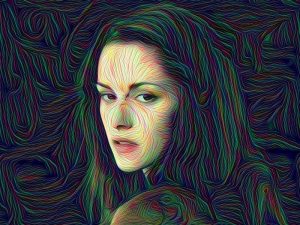
Kristen Stewart, of Twilight fame, co-authored a paper on using deep learning neural networks in her new movie that she is directing. The basic idea is very old but the details and scale are more recent. If you take an artificial neural network and have it autoencode the input stream with bottlenecking, you can then submit any stimulus and will get some reflection of the training in the output. The output can be quite surreal, too, because the effect of bottlenecking combined with other optimizations results in an exaggeration of the features that define the input data set. If the input is images, the output will contain echoes of those images.
For Stewart’s effort, the goal was to transfer her highly stylized concept art into the movie scene. So they trained the network on her concept image and then submitted frames from the film to the network. The result reflected aspects of the original stylized image and the input image, not surprisingly.
There has been a long meditation on the unique status of art and music as a human phenomenon since the beginning of the modern era. The efforts at actively deconstructing the expectations of art play against a background of conceptual genius or divine inspiration. The abstract expressionists and the aleatoric composers show this as a radical 20th Century urge to re-imagine what art might be when freed from the strictures of formal ideas about subject, method, and content.
Is there any significance to the current paper? Not a great deal. The bottom line was that there was a great deal of tweaking to achieve a result that was subjectively pleasing and fit with the production goals of the film. That is a long way from automated art and perhaps mostly reflects the ability of artificial neural networks to encode complex transformations that are learned directly from examples. I was reminded of the Nadsat filters available for Unix in the 90s that transformed text into the fictional argot of A Clockwork Orange. Other examples were available, too. The difference was that these were hand-coded while the film example learned from examples. Not hard to do in the language case, though, and likely easier in certain computational aspects due to the smaller range of symbol values.
So it’s a curiosity at best, but plaudits to Stewart for trying new things in her film efforts.